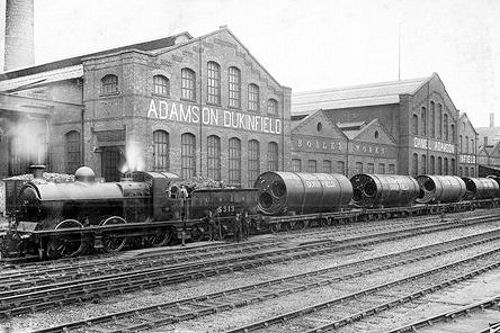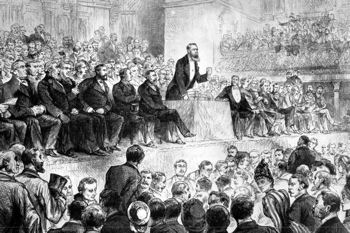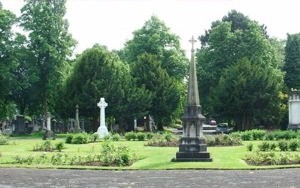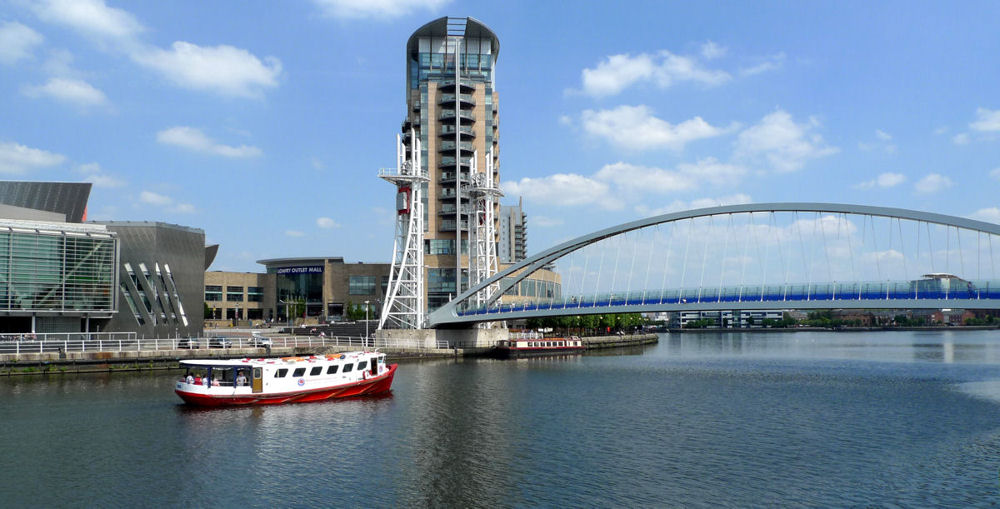Mechanical and Civil Engineer
He had 15 siblings, and my great-great-grandmother was one of them.
1820 April 30 Daniel was born in Shildon, probably at the Grey Horse Inn. His parents were Daniel Adamson (farmer and publican) and Nanny Gibson. He was the 13th of their 16 children. [1]
1833 April 30 On this day, his 13th birthday he left the Edward Walton Quaker School and four days later began his apprenticeship at the Stockton and Darlington Railway works in Shildon under the wing of Timothy Hackworth.
1845 June 10 Daniel married Mary Pickard at the parish church Aysgarth, in Wensleydale. "Rank or Profession" of both of their fathers is recorded as "Farmer". From various census returns it is clear that Mary was born in Danby Wiske, which is a village near Northallerton. [2]
1846 Q4 Alice Ann his first child was born in Shildon
1850 July 7 Daniel's employer Timothy Hackworth died, and later Hackworth's engine works was sold [6]. So it appears that in anticipation of major changes in Shildon Daniel decided to to spread his wings, and having risen to the level of general manager at the engine works he removed to Stockport to take up the post of manager of Heaton Foundry which was on the corner of Gordon Street, Lancashire Hill, Stockport.
1851 Jan 24 Lavinia his second child was born at 1 Appleton's Terrace [aka Appleton Court], Nicholson Street, off Lancashire Hill Stockport. [2] The house was a very modest abode, probably what is known as a two-up-and-two-down with a steep embankment at the end of the back-yard. Now [2010] Nicholson Street has been cleared of the Victorian properties but the cobbled street is still there. On the crest of the embankment there now stands Pendlebury Hall, originally an ophanage; later Stockport Technical School coincidentally the webmaster's alma mater; and now, today the place is a Care Home for the elderly.
1852 In the spring Daniel moved to Ashton, Cheshire to set-up as an iron-master on his own account. The works, his first, became the Newton Moor Iron Works and was north-east of the junction of Talbot Road and Ashton Road, Dukinfied, Cheshire.
1861 In the Census and aged 41 he is described as an engineer employing "128 men and boys"; and "2 farm-men". Residence believed to have been Goodier House, Back Lane, Newton, Hyde [7]. Present were his wife Mary, and daughters Alice-Ann and Lavinia.
1867 CHRISTMAS DAY o o o o Daughter Alice (21) and sister Lavinia (16) were baptised at St.Mary's, Newton-in-Mottram, Cheshire. Coincidentally, Lavinia died on Christmas Day in 1925. (see also 1851). The church is still there on Talbot Road.
1871 In the Census Daniel is described as a Civil and Mechanical Engineer "employing 250 workmen at Newton Moor Iron Works".
1874 Due to lack of space he re-established his business on a new site about a quarter mile to the north, at Johnsonbrook Rd.

An architects scheme

Photograph found via a Tameside Labour Party web-page.
Note the train load of Lancashire boilers
Thanks due to Councillor John Taylor, 28 June 2010 of Tamesside, Cheshire, England, U.K.
Reference only, for the railway buffs :
The locomotive leading this train looks like an L.N.E.R. Robinson J11 .
1882 June 27 Daniel, at his home The Towers, Didsbury [link], was host of 76 influential guests, including some of the wealthiest and shrewest men in Manchester. It was the historic occasion upon which the decision to go ahead with the Ship Canal was made.
1885 August 8 a Saturday. Following the passing of the Ship Canal Act, Daniel the chief promoter of the Bill returned from Parliament to Didsbury. The reception he received from the people of Stockport and Didsbury is the stuff of legends. (see an account of this event here) My grandmother told me in the 1940s that aged 9 she was a guest at The Towers on that day, and I guess, probably in the company of her own grandmother Elizabeth Dent , who was Daniel's sister.

 [5]
[5]Grave of Daniel Adamson, in Southern Cemetery, Manchester
The white memorial to the left, stands over the grave of Sir John Alcock, aviator.
1894 May 21 The Manchester Ship Canal was opened by Queen Victoria.
DANIEL
ADAMSON 1820 -1890
The following was
composed by The
Manchester Literary and Philosophical Society for
inclusion in the Annual Report of
Manchester City Council of 1890.
The name of DANIEL
ADAMSON,
which will be long remembered in
connection with the Manchester
Ship Canal, is also assured a place amongst the distinguished engineers
by the
part which he took
in the development of steam engineering and the use of
steel. Born at Shildon, in 1818 (sic),
Adamson became apprenticed, when seventeen years old, to the celebrated
T.
Hackworth, at the Stockton and Darlington Railway. After
serving here for six years, he was
appointed managing draughtsman and superintendent engineer to the same
company.
This post he held until 1847, when he became manager of the Shildon
works, also
belonging to this Company. In 1849 he
left the service of the Stockton and Darlington Railway, and after
holding for
a short period the position of manager to the Heaton Foundry,
Stockport, he in
1851, commenced business on his own account as Engineer and Boiler
Maker, at
Newton Moor Iron Works, near Manchester.
About this time he inaugurated a series of reforms and improvements in
the construction and manufacture of steam boilers, with which his name
has
become associated. The first of these
consisted in the introduction of the flanged seam for flue tubes, to
replace
the ordinary lap ring seam which was then generally used.
According to Adamson’s method, the flue tubes
are
made in welded sections, the ends of which are provided with a flange
having a radius of one inch to one and a quarter inches in the
bend. Between the two flanges a hoop of flat plate
is placed, and the seams are riveted up by rivets passing through the
flange of
one ring, the hoop, and the flange of the next ring. The seam
thus formed not only adds enormously
to the strength of the tube in resisting
collapse, but also completely overcame the difficulties which had been
previously experienced through the effect of the expansion of the flue
tubes
bulging the end plates. Adamson in 1852
patented this device, which in later years has been generally adopted,
and
still forms one of the features of Lancashire boilers.
Adamson early recognised the part
which steel was destined to play in engineering construction, and
successfully
carried through its application in the manufacture of
boilers. It appears that his application of steel
began about 1857 (Proceedings Iron and Steel Institute, 1879, p.113),
in making
a locomotive for Messrs Talabot, of Paris, to haul iron-stone from the
Bonner
mines in Algeria to the coast. Only puddled
steel could then be got sufficiently ductile, and that was produced at
the
Mersey Steel and Iron Works Company’s works at
Liverpool. About that time Mr. Bessemer patented his
famous process for steel manufacture, and Mr. Adamson at once prepared
to use
the new material for boiler making, and in 1860 he made the first
Bessemer
steel boilers for Messrs Platt Bros., of
Oldham.
These boilers were 30 feet long by 7 feet 6 inches
diameter, and were made of plates only 5/16ths thick for working at a
pressure
of 80lb. ; no better proof of the thoroughness with which Mr. Adamson
completed
his task can be give than the fact that these identical boilers have
remained
in use to this day. But in spite of
Adamson’s strong advocacy of the new material, it was very
little used by
others for many years, chiefly because it was found too unreliable,
owing to
want of knowledge in the choice of treatment
of the metal. Originally, steel of
tensile strength of forty tons to the square inch was used, but
complete
success was not obtained until a milder variety having a tensile
strength of
thirty to thirty two tons, with 20% elongation was adopted, whereas
now-a-days,
in the best practice, engineers are content with a strength of 24 to 28
tons
per sq. inch, and an elongation of not less than 20% in a length of ten
inches. Steel plates made by the Bessemer
or Siemens process, as are not only stronger, but more uniform in
quality than
iron, they are practically not liable to blistering or lamination as
were even
the best iron plates, and they are tougher and more ductile and even
less
liable to deterioration in work than iron plates. In all
first-class boiler work steel plates
are now practically used, to the exclusion of iron.
When steel was first used, it was
found that the plates were seriously damaged by the operation of
punching the
rivet holes, and, to overcome this difficulty, Adamson in 1862
introduced the
method of drilling holes, to avoid distressing the plates. On
Mr. Adamson’s plan, the plates are bent to
their final form, and the holes are drilled through the plates when in
the
position they will occupy in the finished state. The plates
are then taken apart, the burrs
formed by drilling removed, and the plates and seams riveted
up. In this way the holes fall quite true and
fair when brought together, thus avoiding all such drifting as was
customary
with the punched holes to the detriment of the plate. The
holes also being true, each rivet
completely fills its hole, and takes up its proper proportion of the
stress,
whereas in the rough and irregular surfaces of the punched holes, some
rivets
might be taking an undue share of the strain, thus causing rupture at a
point
below the strength of the seam taken generally.
Thus the seam is strengthened and made more reliable, it is less liable
to leakage, the material is better utilised, and the work is altogether
better
and more neatly finished.
These three improvements which
Daniel Adamson has been prominent in bringing forward are the
characteristics
of the modern stationary type of boiler in this country, which is
constructed
for working pressures up to 200lbs. per square inch, and it would
appear that
Mr. Adamson has scarcely received a proportionate amount of credit for
these
important achievements. Moreover when
Adamson commenced boiler making the manufacture of stationary boilers
was
carried on upon the rudest rule of thumb methods, and Adamson was the
first to
bring the system into the construction and manufacture of these boilers
by
proportioning all parts with a careful regard to the forces to be
met. In this way he not only greatly reduced the
weight of the boilers in proportion to their strength, but having
recognised
the economic advantages of using steam at high pressure, he set about
to
construct boilers for pressures greatly in excess of those then in
vogue, and,
as early as 1855, he had made a boiler and engine which worked
successfully
with a steam pressure of 150lbs. Ever
since the theory of multiple expansion was propounded, he was a firm
believer
in the principle, and in 1861, he made the first quadruple expansion
engine
ever constructed.
In the investigation of the
metallurgy of iron and steel, Adamson took a leading part, and few men
could
boast of a more intimate acquaintance with the properties of these
metals based
on experience. Some idea of the amount
of labour Mr. Adamson bestowed upon the investigation of the mechanical
properties
of iron and steel, may be formed from his own remark that up to 1869 he
had
tested from 30,000 to 40,000 specimens of steel suitable for boiler
plates. Not only were his tests more
thorough and complete than any which had preceded them, but he also
made a chemical
analysis of all samples tested, and was amongst the first to make
practical use
of chemical analysis for ascertaining the mechanical properties of iron
and
steel. Adamson proved by his experiments that it was possible to obtain
qualities of mild steel which would be superior to the best iron for
bridge
building and other structures, as well as for boiler work, and in this
way he
aided materially in bringing about the more extended use of steel in
place of
iron. In the early days of steel great
difficulty was also experienced in welding the new material, and
Adamson was
the first to point out the conditions under which successful welding
was
possible.
Mr. Adamson also took an
extremely active part in opening out the Lincolnshire iron fields, and
he was
the first to erect a furnace at Frodingham, in 1866, depending entirely
on its
supplies upon ores found in the district.
The greatest difficulty was, however, in working the ore, as it could
not be fused at the usual temperature of the blast furnace, owing to
the
presence of a large quantity of lime mixed with the ore, and a want of
silica
and alumina. This experience was gained
at great cost, but the difficulty was ultimately overcome by the
addition of
Lincoln siliceous ore, which is combined with a large quantity of
alumina, and
these works have since been very prosperous.
It yet remains to refer to the
crowning work of Adamson’s life, which consisted of rescuing
the Manchester
Ship Canal scheme, and rendering it a practically possible
undertaking. It is a thrice-told story how Adamson, by
force of argument, succeeded in arousing the enthusiasm of the teeming
millions
of Lancashire workers in support of the great scheme, how bravely he
fought the
parliamentary battle in the face of the opposition of the greatest
vested in
the Empire, how the reverses which would have sufficed to paralyse the
powers
of less sturdy men only served to spur Adamson on to renewed efforts,
and how
he finally led the scheme to triumphant victory.
In the great popular agitation
which carried the Ship Canal Bill, Adamson was the chief actor, but
finding
himself less successful in dealing with the financial difficulties he
retired,
leaving others to carry out the work. In
the course of a few years this great monument to the ability and energy
of Mr.
Adamson will be completed, and it is matter of the deepest regret that
he
should not have been spared to see the accomplishment of the great work.
Mr. Adamson took an active share
in the work of the leading technical societies, at the meetings of
which he was
a regular attendant and frequent speaker.
In 1877 he was elected a member of the Institute of Civil
Engineers. In 1888, the Iron and Steel
Institute gave expression to their high opinion of his merits by
electing him
their President, and in the same year he was presented with the
Bessemer Gold
Medal of that body. He was elected a
member of The Manchester Literary and Philosophical Society in 1881,
under the
Presidency of Mr. Binney.
End of this Obituary
________________________
[4] A further obituary transcription may be seen via this link > > Manchester Faces and Places
________________________
[1] "Daniel Adamson, Shildon, 1778 - 1832" by Frank Hutchinson, at Shildon Library. This slim pamplet of 16-A5 sides, describes the nest into which the young Daniel was born
[2] U.K., BMD copy certificates in possession of the webmaster.
[3] Baptisms at the parish church of Newton in Longdendale, in the County of Chester.
[4] Obituaries discovered by Mrs Ivy Dolan, a descendant of one of Mr Adamson's sisters.
[5] Grave memorial photo credit
[6] In Robert Young's book, below. See "Foreward to the 1975 edition".
[7] Residence in 1861 gleaned from the Census. The assumption of 'Goodier House' gleaned from http://hydonian.blogspot.co.uk/2012/04/goodier-house-victoria-street.html
Further reading / URL linking :
Daniel Adamson web page at Wikipedia
MANCHESTER'S SHIP CANAL - THE BIG DITCH, by Cyril J Wood
TIMOTHY HACKWORTH - AND THE LOCOMOTIVE, by Robert Young (Many references to the Adamsons of Shildon)
A CRUISE ALONG THE MANCHESTER SHIP CANAL, by Colin Wilkinson. ISBN 9781904438922
General Notes
a) The town of Hyde had the benefit of another firm of boilermakers. Joseph Adamson & Co. Ltd. The proprieter J.A. also grew up in Shildon and was the son of Daniel's elder brother John, an N.E.R. engine driver. Joseph's son Dr. Daniel Adamson, became a President of the Institute of Mechanical Engineers.
 .
.![Contact post[at]g4fas.net](email.jpg) .
.
© 2008 - 2014 Geoffrey Royle
